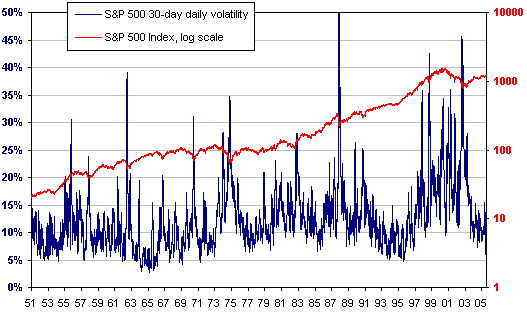Alan Greenspan had his “conundrum,” and I’ve got mine. Greenspan’s conundrum: why are long-term interest rates staying so low for so long? Mine is why stock-market volatility is so low despite a global economic background that, on the face of it, is fraught with risk and uncertainty.
Volatility is simply a fancy word for the amount by which stocks move around. There’s no need to get hung up on precisely how it’s calculated. At times when stocks hardly move at all, like now, volatility is low. At times when they move around a lot, like the crash of October 1987, volatility is high.
As stock prices change, it signals that investors are changing their minds about what stocks are worth. So during times of high volatility, you’d think that investors were being bombarded with new information and new uncertainties that cause them to reappraise stock prices. Times of low volatility are when everybody has everything already figured out.
Do you feel like we have things all figured out now? I’ll bet you don’t. Just look at the headlines. Everybody’s hair is on fire over all the risks the economy faces: terrorist attacks, huge federal budget deficits, mammoth trade deficits, jobs all going to China and India, Social Security and Medicare going bankrupt, and on and on ad nauseam. You know the drill.
Yet for all that, volatility today is the lowest it’s been in almost 10 years. To find volatility lower than that, you have to go back 30 years.
Volatility was twice as high as it is today the day before the September 11, 2001, terrorist attacks. How can there have been more risk and uncertainty before 9/11 than there is now, after 9/11? Now we know that thousands of lives and hundreds of billions of dollars can be evaporated in a moment — isn’t that enough risk for you?
Volatility is telling us we live in a world of no risk now, as though terrorism and all the other threats of today’s world don’t exist. Explaining that isn’t so simple as saying that there really aren’t any risks — although I do believe that many of the most publicized risks today are greatly exaggerated.
The reason that’s not enough of an explanation is that equity valuations are telling us exactly the opposite of what volatility is telling us. As I’ve been writing here all year, stocks are at near-historic valuation lows, when you take forward consensus earnings and interest rates into account. That means you’re getting stocks at a big discount, which is the same thing as saying there’s a big risk premium in stocks.
So here’s the conundrum in a nutshell: How can valuations be telling us that stocks are a terribly risky proposition, when volatility is telling us that there’s no risk at all?
One approach to the conundrum would be to say, “Why ask why?” Just accept it. What better investment opportunity could you possibly ask for? Stocks are cheap, priced as though the end of the world were around the corner. Yet the low volatility is telling you that everything is really just fine. So buy, baby, buy.
Never look a gift horse in the mouth. But at the same time, beware of markets bearing gifts. That free lunch is never really free.
So here’s another view. Maybe today’s low volatility isn’t really telling us that everything is wonderful, but only that investors are being too complacent. Yes, that doesn’t explain why valuations indicate that investors are anything but complacent, but let’s set that aside for a moment.
The view that low volatility is bearish, because it indicates investor complacency, has a long pedigree. Market technicians like my friend Fred Goodman (who publishes a daily technical analysis report on my web site) certainly believes that. And he’s in good company. The great financial economist Fischer Black, one of the creators of the famous Black/Scholes options pricing model, thought that it was one of the very few robust findings in empirical finance.
Yet I can’t really make myself believe it’s true. Take a look at the chart below, going back to 1951. The blue line is S&P 500 volatility (calculated as the annualized standard deviation of daily returns over a rolling one-month period). The red line is the S&P 500 index itself, plotted on a log scale so that percentage moves are comparable at all points on the chart.

One thing’s for sure — most of the really big spikes in volatility are associated with market bottoms. So if I had to write a simple trading rule based on just a glance at this chart, it would be: buy whenever volatility gets above about 35%. That’s when prices are lowest. You could implement this rule by watching the CBOE Volatility Index, known as the VIX.
Yet while extremely high volatility seems to be bullish, it’s not so clear that low volatility is bearish. Take a look at the prolonged period in the mid-1990s when volatility was about as low as it is today. That was the launching pad for one of the greatest bull markets in history.
Here’s my best stab at explaining the conundrum. There’s one factor that makes stocks look cheap and volatilities low at the same time — low interest rates (which brings us back to Greenspan’s conundrum).
Low interest rates reduce risk and uncertainty because they mean that whenever a problem arises, at least you can afford to borrow your way out of it. The same problem that would kill you at 15% interest rates is a piece of cake at 4% interest rates. That’s why volatility is so low even though there are so many risks in our world today.
Low rates also make stocks more valuable, because it means that earnings and dividends have less to compete with. You can afford to pay more for a dollar’s worth of earnings when rates are low, but you should pay less when rates are high.
So as rates gradually move up, the conundrum will disappear. But that doesn’t mean that stocks that look cheap today won’t appreciate dramatically. In our world of low volatility and low rates, it’s easy to see how earnings are just going to keep surging.
So I’m not being naive, but I’m not looking a gift horse in the mouth, either. Stocks really are cheap, and risk really is low. It’s a conundrum, but it’s also a sweet spot — and just because it won’t last forever doesn’t mean it isn’t sweet.
The above is an “Ahead of the Curve” column published July 29, 2005 on SmartMoney.com, where Luskin is a Contributing Editor.









